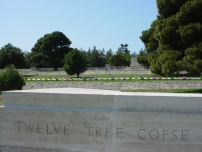| First Name: | George | Last Name: | DURHAM | |
|---|---|---|---|---|
| Date of Death: | 05/06/1915 | Lived/Born In: | Blackfriars | |
| Rank: | Lance Corporal | Unit: | Royal Inniskilling Fusiliers1 | |
| Memorial Site: | ||||
Current Information:Age-27 SDGW-04/06/15 4, Cobham Buildings, Pocock Street, Blackfriars Twelve Tree Copse Cemetery, Helles, Gallipoli Gallipoli 1915 On 25 April, British, Australian and New Zealand forces landed on the Gallipoli peninsula hoping for a quick campaign that would knock Turkey out of the war. But it was not to be. The Turks fought bravely, the terrain was a maze of ravines and very soon the stalemate of trench warfare had set in. Add to this the summer heat, water shortages, dead bodies lying around and millions of flies and the place took on nightmarish proportions. By January 1916, all British, French, Indian, Australian and New Zealand forces had left Gallipoli, leaving only behind the dead, over 56,000 of them. First World War generals and commanders did not emerge from the conflict with their reputations untarnished and although in many cases this was undeserved this was certainly not the case with Major -General Hunter-Weston when he commanded the 29th Division in Gallipoli and this was no more evident than with his handling of the three Battles of Krithia. He lacked imagination, had little regard for casualty figures and had no alternative plans to the frontal assault he favoured so much and which inevitably came to grief at great human cost. The overall commander General Hamilton should of course have intervened but he was too much of a gentleman for ‘caddish’ behaviour such as questioning another General’s tactics, so thousands of men needlessly died.
Third Battle of Krithia 4th June, 1915 Krithia is a small village standing astride the Gallipoli peninsular about three miles inland from Cape Helles. In 1915 possession of the village by the Allies would be an important stage in capturing the heights of Achi Baba which lay beyond it. The first two attempts had ended in failure but that did not deter Hunter-Weston employing the same tactics once more, only this time with more modest objectives of an 800 yard advance rather than taking Ach Baba in one go. But they were beset by the constant problem of a shortage of artillery and grenades, both essential in trench warfare. In the centre of the line the attack of 127 Brigade and 88 Brigade went well and enemy trenches were captured but on the two flanks little or no progress was made. Hunter-Weston then made the fatal mistake of sending his reserves to the flanks, supporting the failure there, rather than sending them to the centre to exploit the success there. It was not long before those units that had got forward found themselves isolated and in danger of being cut off and had no option but to withdraw. By nightfall it was all over. Some land had been gained, but nothing of any significance, and there were 6,500 more British and French casualties. For this action, 1st Royal Inniskilling Fusiliers, of 87 Brigade, 29th Division were in close support to 1st Lancashire Fusiliers who were attached to the 29th Indian Brigade which attacked on the left of the line. On this section of the front the artillery bombardment had been far from adequate and the enemy trenches and various strongpoints were largely undamaged. 1st Lancashire Fusiliers attacked along the centre of Gully Spur with the 14th Sikhs on their right moving along Gully Ravine and almost inevitably both were halted and then forced back. By early afternoon they were back at their starting lines except for the many dead and wounded still out in no-man’s land. Among the casualties suffered by 1st Royal Inniskilling Fusiliers in this action was George Durham. |
||||
| « Back to Search Results | ||||
| If you think any of the information shown here is incorrect, Click Here to submit your amends and comments | ||||




